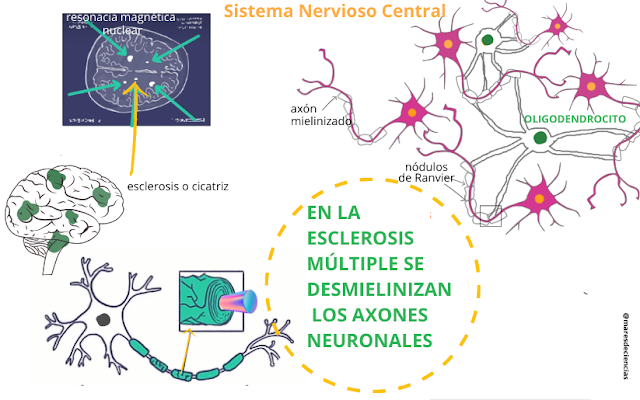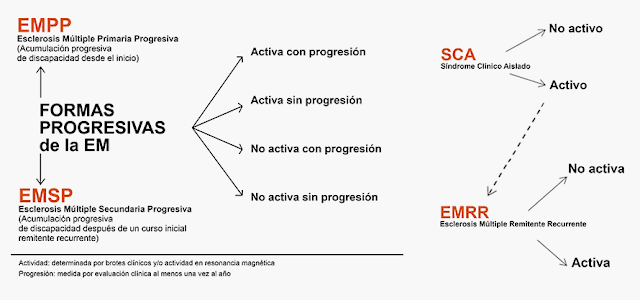CARDS FROM 2 TO 7 OF WANDS
MULTIPLE SCLEROSIS
Cards from 2 to 7 of Wands: Multiple Sclerosis
This week they are talking about multiple sclerosis, a disease of the central nervous system that arises when the loss of myelin that covers neuronal axons “short-circuits” correct nerve transmission.

Neurodegenerative diseases encompass a broad group of pathologies that can affect both our central nervous system (brain – cerebrum, cerebellum, medulla oblongata – and spinal cord) and the peripheral nervous system (ganglia and nerves). Despite their diversity and complexity, all of them are accompanied by a more or less progressive process of chronic neuroinflammation that ultimately leads to neuronal degeneration and death.

Multiple sclerosis is an inflammatory disease that affects the central nervous system. It is characterized by being:
- Neurodegenerative: causes damage to neurons and alters the transmission of nerve impulses.
- Chronic: in 10% of patients the disability progresses from the beginning of the disease and in 90% it does so by alternating acute episodes or outbreaks that completely or partially remit, leaving more or less neurological sequelae [1].
- Unpredictable: its evolution cannot be foreseen with certainty.
- Heterogeneous: also called “disease of a thousand faces” due to the variety of symptoms—both physical and cognitive—which manifest in different ways and to different degrees depending on the place in the central nervous system where the demyelination injury occurred.
- Demyelinating: occurs due to degeneration of the myelin sheath of the axon.
- Autoimmune: it is the immune system of the affected individual that produces antibodies that attack the protective myelin sheath that covers the nerve fibers, generating communication problems between the brain and the rest of the body. As myelin clumps are toxic, the pro-inflammatory environment they generate around them causes the recruitment of microglia to eliminate them. In the initial stages of the disease, microglia are able to resolve the situation and return to normal. This has been related to the alternation between flares and normal situations that appears in the type of multiple sclerosis known as relapsing-remitting (which affects 90% of patients). However, as the immune system continues to attack the myelin sheaths, neuroinflammation becomes chronic. Together with deficiencies in myelin phagocytosis, both processes generate an inflammatory feedback that is increasingly difficult to resolve, until a point is reached where the system cannot cope and the disease progresses.
- Not contagious or hereditary, although there appears to be some genetic susceptibility. Both environmental factors (diet, stress, viruses, lack of vitamin D, smoking, intestinal flora…) and the genetic predisposition of each individual to recognize a component of their own central nervous system as foreign: myelin play a role in its appearance. . It seems that infection with the Epstein-Barr virus could act, in certain individuals, as a triggering factor for the disease [2].

Types of multiple sclerosis. Source: Multiple Sclerosis Spain
https://esclerosismultiple.com/esclerosis-multiple/tipos-de-esclerosis-multiple/

Symptoms of multiple sclerosis. Source: Multiple Sclerosis Spain
https://esclerosismultiple.com/publicacion/infografia-de-sintomas-de-la-esclerosis-multiple/
Multiple sclerosis affects approximately 2.8 million people worldwide and one case is diagnosed every 5 minutes [3]. The age of onset of multiple sclerosis is between 20 and 40 years and it is usually diagnosed, on average, at 32 years of age. In this age group it is the second cause of disability, after traffic accidents. Multiple sclerosis is more common in women, who make up about 75% of patients, and has a very particular worldwide distribution, with a higher incidence in northern European countries, Canada and the United States [4].
Although it seems that the first case of multiple sclerosis was described in Holland in 1421, it was not until 1868 when the French pathologist Jean-Martin Charcot linked the sclerotic plaques he observed in the brain of a young woman with the disorders she suffered in life to diagnose for the first time multiple sclerosis as a disease [5].

Although there is currently no cure for multiple sclerosis, there are numerous treatments that promote recovery from flares, treat specific symptoms or modify the course of the disease [6]. In the last 20 years, research has advanced enormously, and today there are numerous treatments for people who have relapsing-remitting multiple sclerosis. Furthermore, increasing understanding of the mechanisms of disease progression has allowed the development of effective disease-modifying treatments, which manage to delay or stop disability in progressive forms of the disease. Until now, the existing immunomodulatory and immunosuppressive treatments (about 15) seek to stop neuroinflammation combined in different therapeutic strategies, depending on the patients’ situation in terms of activity (flares, active lesions in MRI) or the progression of disability [ 1] [7].
New lines of research are moving towards the development of remyelination treatments that repair damaged myelin and prevent permanent nerve damage, and treatments that protect nerves from damage to slow or stop the progression of the disease. At the Cajal Institute, the Developmental Neurobiology Group led by Fernando de Castro Soubriet investigates the potential of oligodendrocyte precursor cells (OPCs) in the treatment of multiple sclerosis. These OPCs, which have been observed in different structures of the central nervous system of adult individuals, are fundamental in the study of the plasticity of the central nervous system, as well as in memory and learning processes. Faced with the loss of oligodendrocytes caused by the disease, OPCs are able to react and, under favorable conditions, spontaneously remyelinate, at least in part, the damage caused. Drugs are being explored that can enhance the myelinating-remyelinating properties of OPCs in adults, to propose neuroreparative treatments that support those currently available [7][8].
There is still much to discover, but as research continues to advance and progress, there is more hope for multiple sclerosis sufferers every day. International Multiple Sclerosis Day, celebrated on May 30, seeks to give visibility to this disease to make the lives of those who suffer from it easier.
Have you been curious and want to know more?
MULTIPLE SCLEROSIS ASSOCIATIONS AND FOUNDATIONS
Multiple sclerosis Spain: https://esclerosismultiple.com/
Spanish Multiple Sclerosis Association https://aedem.org/
Interactive portal of Multiple Sclerosis in Spain: https://fundaciongaem.org/esclerosis-multiple-en-linea/
Fundació GAEM – MS research Group d’Afectats d’Esclerosi Múltiple https://fundaciongaem.org/
Spanish Multiple Sclerosis Network https://reem.es/que-es-la-reem/
MS international federation https://www.msif.org/
SOURCES CITED AND NOTES
[1] 20 minutes with… Dr. Óscar FERNÁNDEZ. SPMS: definition, epidemiology- Predictive factors for the transition from RRMS to EMS and evolution. June 30, 2021. EM online, GAEM Foundation. https://fundaciongaem.org/esclerosis-multiple-en-linea/emsp-definicion-epidemiologia-factores-predictivos-del-paso-emrr-emsp-evolucion/
[2] ROBINSON, William H. and Lawrence STEINMAN (2021). Epstein-Barr virus and Multiple Sclerosis. SCIENCE,13 Jan 2022, Vol. 375, Issue6578, pp. 264-265https://www.science.org/doi/10.1126/science.abm7930
[3] Multiple Sclerosis International Federation (2020). World Atlas of Multiple Sclerosis, 3rd edition. PART ONE: World map of multiple sclerosis: the most important epidemiological conclusions (September 2020). Spanish version https://esclerosismultiple.com/wp-content/uploads/2021/04/Atlas-Epidemiology-report-Sept-2020-Final-ES.pdf video https://twitter.com/MSIntFederation/status/1304396777408221184
[4] Drawing Multiple Sclerosis: What is MS? (2018). Sanofi Spain informative video https://www.youtube.com/watch?v=q41RRAZpLr8&t=21s
[5] FERNÁNDEZ, Tomás and Elena TAMARO (2004). Biography of Jean-Martin Charcot. In Biographies and Lives, the online biographical encyclopedia [Internet]. Barcelona, Spain. https://www.biografiasyvidas.com/biografia/c/charcot.htm
[6] YouTube Channel Cerebrotes, by Clara García. Multiple Sclerosis: cause, types, symptoms and diagnosis (2021) https://www.youtube.com/watch?v=L9LmRgE9f4Y
[7] Research in multiple sclerosis. Multiple Sclerosis Spain https://esclerosismultiple.com/investigacion/
[8] DE CASTRO SOUBRIET, Fernando (2016). Oligodendrocyte precursors. EM online, GAEM Foundation https://fundaciongaem.org/esclerosis-multiple-en-linea/precursores-de-oligodendrocitos-una-revolucion-a-mano-para-reponer-el-dano-en-la-esclerosis- multiple/
OTHER LINKS OF INTEREST
MORALES GARCÍA, José A. (2021). Multiple sclerosis: this is how the immune system “nibbles” at our neuronal connection. The Conversation, 16.12.2021 https://theconversation.com/esclerosis-multiple-asi-mordisquea-el-sistema-immunitario-nuestra-conexion-neuronal-173866
Understanding multiple sclerosis (2016). Roche Spain https://www.youtube.com/watch?v=gbkrlXuzodU&t=61s
History of multiple sclerosis https://www.roche.es/es_es/esclerosis-multiple/historia.html
FundacioEM YouTube Channel
Understanding the symptoms of spasticity in multiple sclerosis (Almirall Laboratories video) https://www.youtube.com/watch?v=HO3Zl3GTUSg
Sanofi Spain YouTube Channel, video series Drawing MS:
What is MS? https://www.youtube.com/watch?v=q41RRAZpLr8&t=21s
Diagnosis https://www.youtube.com/watch?v=kLsgCdnHbUY
Symptoms and types: https://www.youtube.com/watch?v=iNQkaEpGa1I
What is an outbreak? https://www.youtube.com/watch?v=szSqjwUNkhQ
Pain and MS https://www.youtube.com/watch?v=aJ67b9OonZk
Cognitive impairment https://www.youtube.com/watch?v=qDwJA4uaDdE
Urinary and intestinal disorders https://www.youtube.com/watch?v=Y0p5u1TPNfA
Diets https://www.youtube.com/watch?v=bRcHS7yotiY
Sexual dysfunction https://www.youtube.com/watch?v=LXo9CMaIW6Q
Brain atrophy: https://www.youtube.com/watch?v=NSu4TDj7C4A
Documentary video «Multiple Hopes» https://www.youtube.com/watch?v=yLWTyXmg5x0
Roche Spain YouTube Channel
Understanding multiple sclerosis https://www.youtube.com/watch?v=gbkrlXuzodU
Synapsis EMP YouTube Channel
What is multiple sclerosis https://www.youtube.com/watch?v=NUtFiw5yRTk
YouTube Channel Draw my Life in Spanish
What is multiple sclerosis? https://www.youtube.com/watch?v=O3K0vLcTkjY&t=7s
